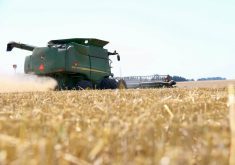U.S. live cattle futures fell about one per cent on Monday, rocked by cash cattle price caution and fund selling, said analysts and traders.
Chicago Mercantile Exchange (CME) feeder cattle closed weaker but hogs finished higher.
CME live cattle began the week in negative territory. Additional deliveries pressured August while October investors were cautious as they waited for cash cattle to change hands, said traders.
They said fund selling developed after August and October fell below their respective 100-day moving average level of 118.81 and 123.64 cents (all figures US$).
Read Also

U.S. grains: Soybeans hit six-week low as Brazilian harvest looms; corn, wheat sag
Chicago | Reuters – Chicago soybean futures fell to six-week lows on Friday as worries about slowing export demand for…
Thinly-traded spot August live cattle closed down 1.475 cent per pound, or 1.23 per cent, to 118.4 cents. October ended at 123.475 cents, down 0.975 cents or 0.78 per cent.
Traders are pricing in a possibly lower cash trade based on packers needing fewer cattle because of one less slaughter day during the Labour Day holiday on Sept. 3, said Country Hedging market analyst Tregg Cronin.
Last week, cash cattle in the southern Plains sold fully steady with the week before at $120 to $121 per hundredweight (cwt). Live-basis cattle in Nebraska traded $1 to $2 lower at $119 to $120, said feedlot sources.
Wholesale beef buying interest has waned after supermarkets topped off on-hand inventories for Labour Day grilling specials and for product features after the holiday, traders said.
The U.S. Department of Agriculture estimated the Monday morning choice wholesale beef price at $192.55 per cwt, up 41 cents from Friday but down $1.30 from the same day last week.
CME feeder cattle fell on spillover live cattle market losses, but were cushioned by the drop in corn prices that could help ease feed input costs for cattle feeding operators.
Spot August feeder cattle closed 0.225 cent/lb. lower, or 0.16 per cent, at 140.275 cents. Most-actively traded September finished at 142.65 cents, down 0.3 cent or 0.21 per cent.
Hogs jump
CME hogs finished up around one per cent, lifted by short-covering and futures’ discount to cash hog prices, said traders and analysts.
Also, some futures buyers are banking on unconfirmed talk that a foreign importer might be in the market soon for U.S. pork at lower prices for later use.
"Some guys are afraid to be short this market. Our senses are heightened thinking something is going on behind the scenes with exports, but we don’t know what it is," said independent hog futures trader James Burns.
October hogs closed up 0.875 cent, or 1.21 per cent, at 73.250 cents per lb. December finished up 0.475 cent, or 0.67 per cent, at 71.05 cents.
Others remained skeptical about the day’s advances given increased supplies and the upcoming holiday, reducing packer need for supplies.
USDA estimated Monday’s slaughter at 432,000 hogs, up 8,000 from the same day last week and 9,000 more than for the same period a year ago.
In recent weeks, moderate temperatures allowed hogs to grow at a faster rate. Some producers marketed their hogs earlier than usual due to high-priced feed, the result of the worst U.S. drought in more than 50 years.
And a few hog farmers hurried their animals to market knowing packers typically lower cash bids for hogs a week or so before major U.S. holidays.
— Theopolis Waters writes for Reuters from Chicago.














